Pitcher plants, specifically from the genus Nepenthes, have evolved unique adaptations to thrive in the Philippines' nutrient-poor, acidic soils. These plants have modified leaves shaped like pitchers that contain digestive fluids to trap and digest insects, providing essential nutrients. For instance, the leaves of Nepenthes alata have a slippery peristome, making it difficult for prey to escape. Additionally, some species have elongated tendrils that guide insects towards the pitcher's entrance.
Nepenthes species exhibit diverse morphology to attract prey. Some plants have specialized nectar glands that produce sweet, sticky substances to lure insects. For example, Nepenthes ventricosa has a distinctive lid-like structure that prevents insects from flying out once they enter the pitcher.
Beyond nutrient acquisition, Nepenthes plants play a vital ecological role. They support infauna, such as insects and spiders, which live within the plant's pitchers and enhance the local ecosystem's health.
Conservation efforts are necessary to protect Nepenthes habitats. Habitat loss due to human activities poses a significant threat to these unique plants. It is essential to preserve their habitats to ensure the continued survival of Nepenthes species and the ecosystem they support.
Overview of Pitcher Plants
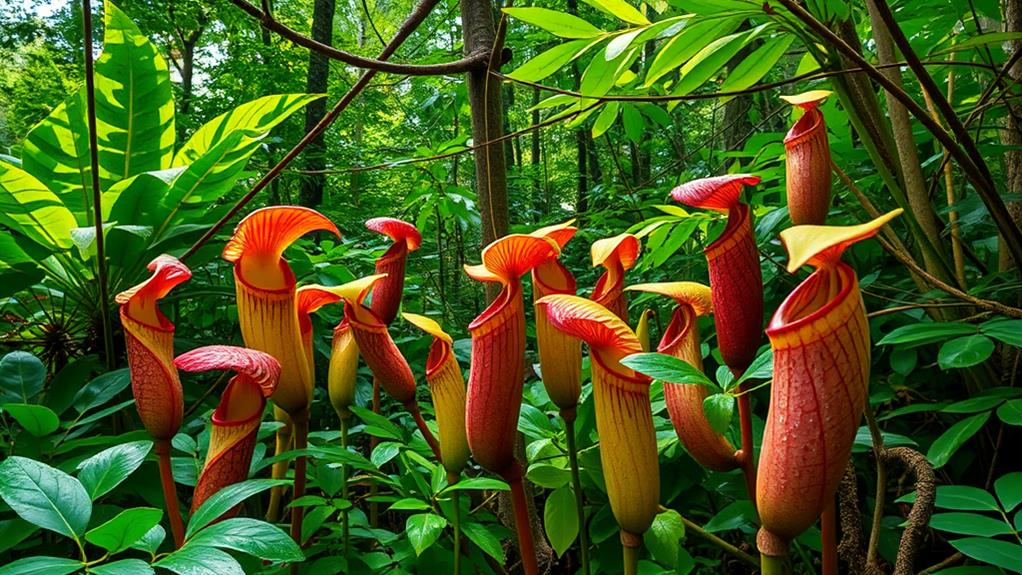
Pitcher Plants: Unique Adaptation Strategies
Carnivorous plants, specifically those in the genus Nepenthes, have evolved remarkable adaptation strategies to thrive in nutrient-poor environments. These plants utilize specialized pitfall traps, or pitchers, filled with digestive fluids to attract and digest insects.
The morphology of Nepenthes is distinct; elongated tendrils support pitcher-shaped leaves that vary in size, color, and shape, enabling them to adapt to different types of insects. For instance, some species have large, red pitchers with slippery surfaces, while others have smaller, green pitchers with sweet nectar.
In the Philippines, several endemic species of Nepenthes thrive in montane forests and tropical climates. Each species employs a combination of sweet nectar and slippery peristomes to lure prey, ensuring that insects can't escape once they enter the pitcher.
This strategy allows Nepenthes to absorb essential nutrients, crucial for their survival in nutrient-poor soils.
There are over 170 documented species of Nepenthes globally, with ongoing research uncovering new varieties. These plants play a vital role in their ecosystems by controlling insect populations and showcasing the incredible adaptability of life in challenging environments.
Understanding the genus Nepenthes enhances our appreciation for biodiversity and the complexities of ecological interactions.
Taxonomy of Nepenthes
The Taxonomy of Nepenthes: A Complex and Fascinating Classification
The taxonomy of Nepenthes, a genus of carnivorous plants, is complex and fascinating due to their diverse evolutionary adaptations. There are over 170 recognized species of Nepenthes, each with unique characteristics.
One such species is Nepenthes philippinensis, endemic to the Philippines, particularly in Palawan and the Calamian Islands. This species was first described by Macfarlane in 1908 and is closely related to Bornean species like N. hirsuta and N. hispida.
Nepenthes species can be broadly classified into lowland and highland groups based on their altitude preferences. Lowland species thrive in warmer, humid environments, while highland species are suited to cooler, misty conditions.
This classification highlights their ecological adaptability. For example, N. philippinensis, a lowland species, has shallow root systems and climbing tendencies, illustrating its evolutionary strategy for nutrient acquisition.
Nepenthes philippinensis exhibits unique pitcher-shaped leaves that can reach heights of up to 30 cm. These leaves showcase a variation in coloration from green to reddish.
As members of the Nepenthaceae family, Nepenthes plants play a crucial role in their ecosystems, attracting and trapping insects for sustenance. This exemplifies the intricate dynamics of carnivorous plant taxonomy.
Unique Morphology
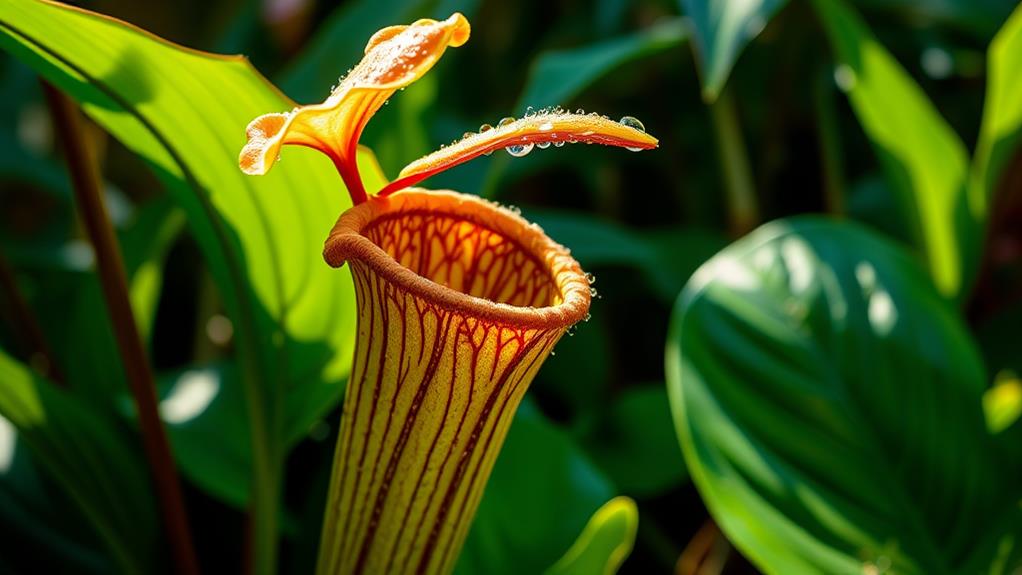
Unique Morphology of Nepenthes Species
Nepenthes species exhibit a unique morphology that sets them apart in the plant kingdom, showcasing adaptations that enhance their carnivorous lifestyle.
Pitcher-Shaped Leaves
The hallmark of Nepenthes species is their pitcher-shaped leaves, which can grow up to 30 cm in height. These specialized structures are designed to efficiently trap and digest prey using a viscoelastic fluid.
The tendrils that extend from the leaf tips vary in length, allowing the plant to reach for support while increasing its capacity to capture insects.
Peristome and Pitcher Morphology
The peristome, or rim of the pitcher, features a slippery texture that aids in preventing prey from escaping after they fall into the trap.
Lower pitchers are typically larger and more colorful, specifically attracting crawling insects, while upper pitchers are smaller and less vibrant, targeting flying insects.
This strategic differentiation in pitcher morphology enhances feeding efficiency across various insect types.
Nectar Glands and Luring Insects
Sweet nectar glands located around the pitcher mouth play a crucial role in luring insects.
These glands produce a sugary substance that attracts and incapacitates potential prey, ensuring they tumble into the digestive fluid.
This unique morphology exemplifies the evolutionary adaptations of Nepenthes and underscores their successful carnivorous lifestyle.
Habitat Preferences
Nepenthes species require specific environmental conditions to thrive. These tropical pitcher plants predominantly inhabit nutrient-poor, acidic soils abundant in their natural habitats across the Philippines. Many species flourish at altitudes ranging from 0 to 600 meters, particularly in the montane forests of the Palawan and Calamian Islands.
High humidity levels, typically exceeding 60%, are crucial for optimal growth. This is because Nepenthes species are highly adapted to tropical climates. Some species are suited to highland environments, where cooler nights and warmer days create a suitable microclimate. In contrast, lowland species thrive in warm, humid conditions near sea level.
Nepenthes species occupy various ecological niches due to their adaptability. Notably, their unique adaptations enable them to flourish in ultramafic habitats, such as the Dinagat Islands, where the soils are rich in nickel and magnesium.
Understanding these habitat preferences is key to conserving Nepenthes species, as they face threats from habitat destruction and climate change. By recognizing their specific environmental needs, we can better protect the ecosystems that support these fascinating carnivorous plants.
Prey Capture Mechanism
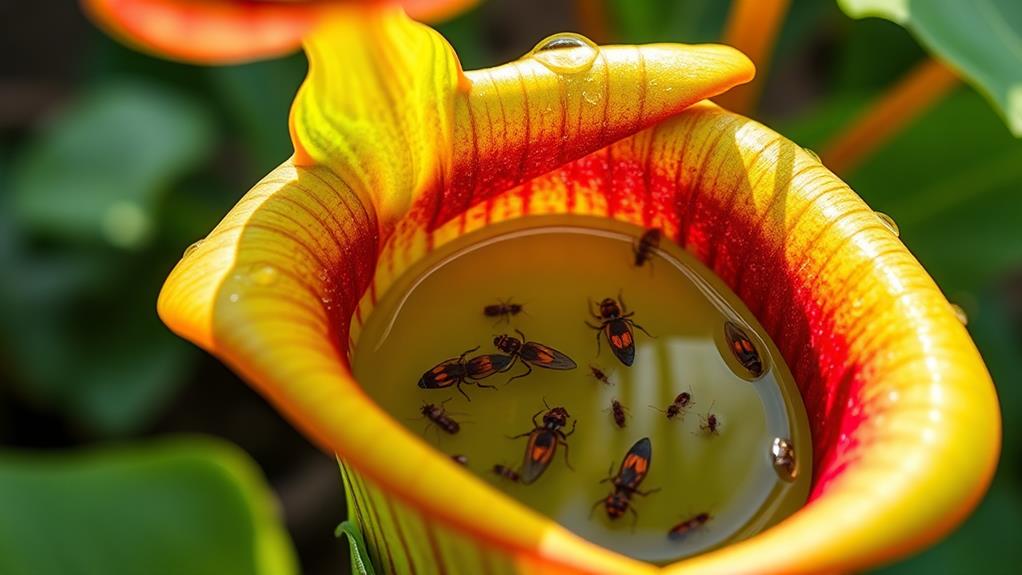
Nepenthes species have evolved remarkable adaptations to capture and digest prey, primarily insects, using modified leaves called pitchers.
The pitcher's peristome is slick and slippery, luring insects with its unique shape and coloration, making it difficult for them to escape once they land on the rim.
Inside the pitcher, a specialized digestive fluid awaits, adapted to drown and break down prey. For example, N. albomarginata has evolved to target specific prey types like termites, demonstrating exceptional evolutionary specialization.
The operculum, or lid, plays a vital role by preventing rainwater from diluting the digestive fluid, maintaining its potency for effective nutrient absorption.
The digestive fluid contains biopolymers that help retain captured insects, facilitating their breakdown.
This process allows Nepenthes to absorb essential nutrients like nitrogen and phosphorus, which are often scarce in their native habitats.
Such intricate mechanisms enable these plants to thrive in nutrient-poor environments, showcasing their remarkable adaptations to survival.
Ecological Relationships
Carnivorous Plants' Ecological Relationships
Carnivorous plants, like those found in the Philippines, have evolved complex relationships with their environment and various organisms to enhance their survival and nutrient acquisition.
Nutrient Acquisition
Carnivorous plants obtain essential nutrients like nitrogen and phosphorus from their diet. For example, Nepenthes species attract insects using vibrant pitchers and sweet nectar, which provide them with these vital nutrients.
Mutualism with Ants
Some carnivorous plants, such as N. bicalcarata, offer nesting space to carpenter ants. In return, the plants benefit from the nutrients released in the ant waste.
Infaunal Contributions
Larvae of mosquitoes and flies inhabit the pitchers of carnivorous plants, aiding nutrient cycling and promoting the ecosystem's overall health. These larvae break down organic matter and recycle nutrients, which benefits the plant and the ecosystem.
Prey Specialization
Certain species of carnivorous plants have evolved to trap specific prey, highlighting their ecological niche. For instance, N. albomarginata has evolved to trap termites, which provide a unique source of nutrients.
Mutual Benefits
Carnivorous plants not only rely on insects for sustenance but also foster an environment where various species thrive together.
For example, the interplay between Nepenthes and tree shrews illustrates the mutual benefits gained from sugary exudates and nutrient-rich droppings, reinforcing their ecological significance.
Reproductive Characteristics
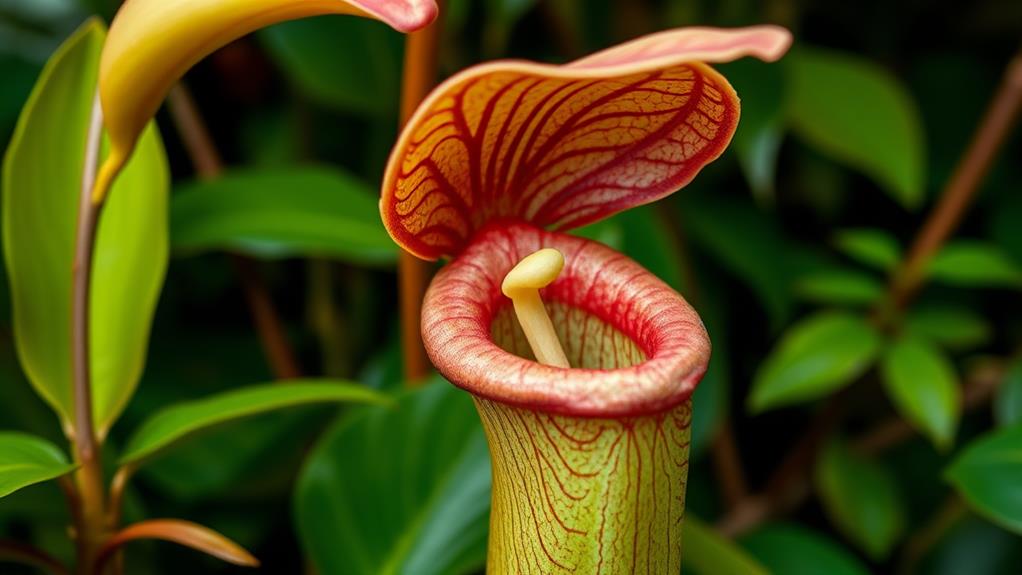
Nepenthes Species' Reproductive Strategies
The reproductive strategies of Nepenthes species in the Philippines demonstrate their adaptability and evolutionary success. They exhibit a dioecious reproductive strategy, producing male and female flowers on separate individuals, which enhances genetic diversity. This strategy allows for cross-pollination between different plants, increasing genetic variation.
Some Nepenthes species can produce up to 190 concurrent inflorescences, significantly increasing their potential reproductive success.
Pollination Mechanisms
Pollination primarily relies on various insects, such as flies, moths, wasps, and butterflies. These insects are lured by the flowers' sweet nectar, which serves as an attractant and facilitates successful pollination. The flowers are arranged in racemes or panicles, optimizing their visibility to pollinators.
Seed Production and Dispersal
Once pollination occurs, the plants produce four-sided capsules containing between 50 to 500 seeds. This ensures a high potential for dispersal and germination in suitable habitats.
Genetic Robustness
The diploid chromosome number of 80 in Nepenthes species indicates a history of paleopolyploidy. This may contribute to their genetic robustness, which is vital for adapting to changing environments and reinforcing their reproductive success.
Infauna and Their Role
Infauna play a vital role in the ecology of Nepenthes pitchers in the Philippines. These organisms contribute significantly to nutrient cycling and the overall health of the Nepenthes ecosystem.
There are four key aspects to their role:
Decomposition occurs through infaunal species. Mosquito and fly larvae, along with spiders and crabs, help break down trapped prey, making nutrients more accessible to the plant.
Infauna have evolved specialized adaptations. Some species, termed nepenthebionts, have developed unique traits that enable them to thrive solely within the pitcher environment.
Infauna enhance nutrient availability. By decomposing organic matter, they support the growth of Nepenthes in nutrient-poor soils, ensuring these plants can flourish.
Infauna attract pollinators. The diverse assembly of infauna draws various pollinators, further aiding in the reproductive success of the plant.
The presence of infauna indicates ecological health. It also exemplifies the intricate symbiotic relationships within these unique ecosystems.
Their role is essential for maintaining the delicate balance that allows Nepenthes to thrive in challenging conditions.
Conservation Status
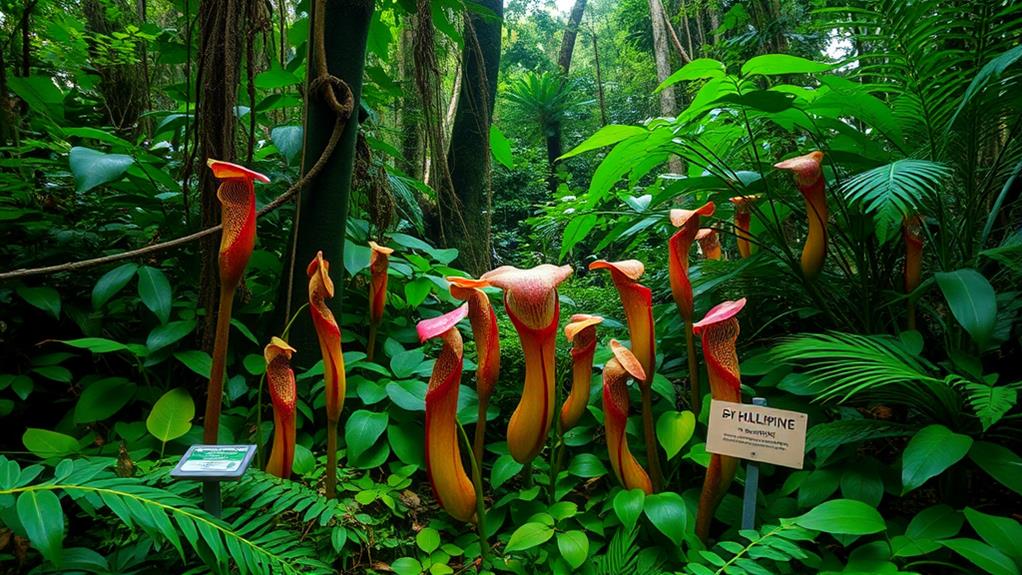
Conservation Status of Nepenthes Species
The conservation status of Nepenthes species is a pressing concern due to the delicate balance they maintain within their ecosystems.
Many Nepenthes species in the Philippines face significant threats, primarily from habitat loss due to deforestation and agricultural expansion.
The IUCN lists Nepenthes philippinensis as Least Concern, but emerging assessments indicate it may be vulnerable due to its limited distribution and specific habitat needs. This highlights the necessity for targeted conservation efforts.
Nepenthes maximoides is assessed as Critically Endangered and possibly extinct, with its habitat confined to a narrow region on Mount Banahaw.
Preserving montane forests and ultramafic soils is vital for maintaining the integrity of these ecosystems.
Ongoing research is crucial to provide insights into the population dynamics and ecological requirements of Nepenthes species.
By developing informed, sustainable management strategies, you can contribute to the conservation of these remarkable plants.
Protecting their habitats isn't just about saving Nepenthes; it's about preserving the intricate ecological balance that supports them and the myriad organisms that depend on these unique ecosystems.
Cultivation Techniques
Cultivating Nepenthes species requires meticulous attention to their specific environmental needs to ensure successful growth and development. To achieve optimal conditions, consider the following cultivation techniques:
Soil Mix: Use a loose, well-drained mixture of sphagnum moss and orchid bark. This promotes moisture retention while allowing aeration for healthy root development.
Humidity: Maintain high humidity levels above 60%. Greenhouse environments often provide ideal conditions for these plants, as they can retain moisture effectively.
Temperature Control: Understand the specific temperature preferences of your species. For example, Highland Nepenthes thrive in cooler nights (50°F to 63°F) and daytime temperatures around 70°F, while Lowland species prefer warmer conditions, ranging from 60°F to 90°F.
Watering and Fertilization: Regular overhead watering is crucial, avoiding standing water.
Daily misting further enhances humidity.
Fertilize with light foliar applications once or twice a month, using fertilizers safe for carnivorous plants to encourage robust growth and pitcher formation.
Notable Hybrids
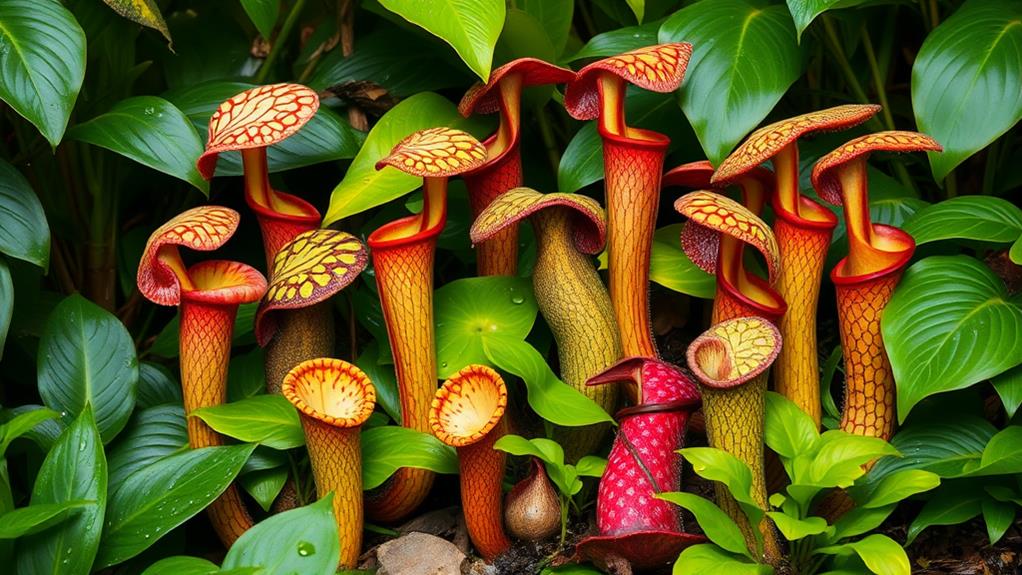
Notable Hybrids
Hybridization within the Nepenthes genus has led to the creation of unique and fascinating plants. Nepenthes ventricosa × N. lowii is a notable example, combining the traits of both parent species to produce distinct pitcher shapes and enhanced nutrient capture abilities.
Another prominent hybrid, Nepenthes alata × N. ventricosa, boasts vibrant coloration and resilience in cultivation, making it a popular choice among growers.
Some hybrids, such as Nepenthes robcantleyi × N. hamata, showcase distinct morphological features like spiky peristomes and diverse coloration, increasing their horticultural appeal.
Nepenthes × ventrata is widely cultivated due to its adaptability and ease of growth, often serving as an introduction to the Nepenthes genus for novice growers.
The hybridization process has resulted in a remarkable range of characteristics, including increased variability in size, shape, and coloration.
This diversity not only increases interest in cultivating these species but also highlights the importance of conserving them in the wild.
Global Biodiversity Impact
Global Biodiversity Impact of Nepenthes
The Philippines is home to a unique array of ecosystems, where the discovery of Nepenthes species has significantly enriched global biological diversity. These carnivorous plants play a vital role in maintaining ecosystem health and supporting complex ecological networks.
Endemic Richness
Approximately 150 Nepenthes species exist, with many endemic to the Philippines, enhancing regional biodiversity. This remarkable diversity highlights the importance of preserving the country's unique ecosystems.
Ecosystem Health
Nepenthes plants interact with various organisms, maintaining local food webs and ecosystem stability. For example, they obtain essential nutrients by capturing and digesting insects, which in turn supports the local food chain.
Conservation Indicators
Nepenthes species serve as indicators of environmental health, reflecting habitat loss and climate change. By monitoring their populations, scientists can gain insights into broader environmental changes. This is crucial for developing effective conservation strategies.
Threatened Habitats
Conservation efforts focused on Nepenthes habitats protect unique ultramafic ecosystems from deforestation and mining, which is essential for global biodiversity. Preserving these habitats also safeguards the rich biological tapestry of the Philippines.
Recent Discoveries
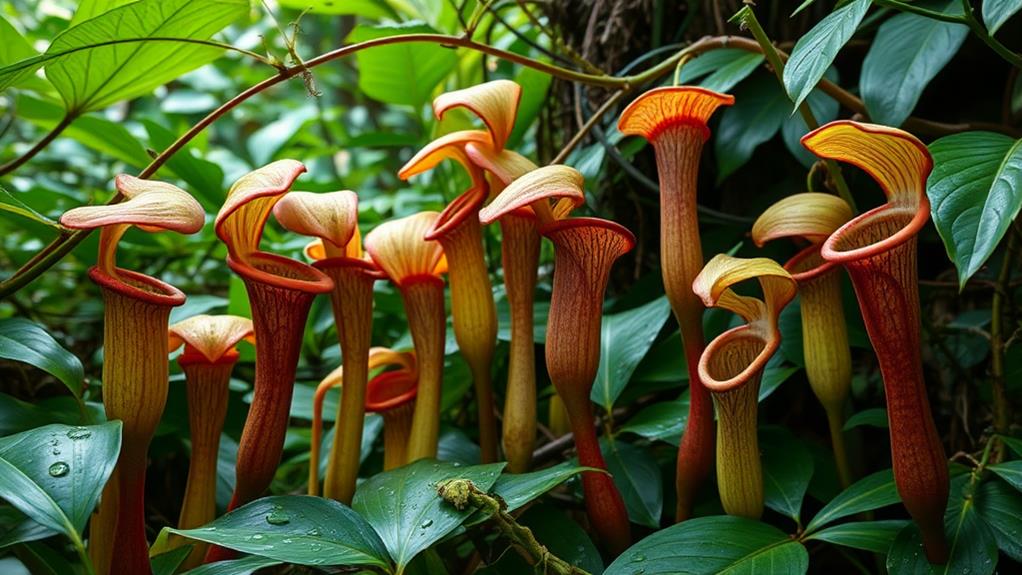
Recent explorations in the Philippines have led to significant discoveries within the Nepenthes genus, highlighting the region's ecological richness.
A century-old mystery has been resolved with the rediscovery of Nepenthes maximoides, a species known only from a single specimen collected over 100 years ago. This raises concerns about its potential extinction.
On the other hand, Nepenthes philippinensis, endemic to the Philippines, has been found to have an impressive adaptation, showcasing the highest number of concurrent inflorescences recorded – up to 190 on a single plant. This remarkable trait emphasizes the rich biodiversity present within this genus.
Nepenthes erucoides, a micro-endemic species, has been found to thrive in the ultramafic soils of the Dinagat Islands, illustrating unique adaptations for nutrient acquisition through carnivory.
The total number of known species has doubled in the last 20 years, with regular identification of new species.
This highlights the urgency of conservation efforts, as many of these newly discovered species may already be at risk of extinction.
Immediate action is crucial to preserve this extraordinary biodiversity before it's too late.
Threats to Survival
Threats to Nepenthes Survival in the Philippines
The discovery of new Nepenthes species in the Philippines highlights the urgent need to address the threats facing these carnivorous plants.
Habitat Loss: The natural habitats of Nepenthes are rapidly being destroyed due to deforestation and agricultural expansion. This is particularly evident in concentrated regions where these plants thrive.
Mining Activities: Mining operations in ultramafic areas disrupt delicate ecosystems, severely impacting species like Nepenthes erucoides and pushing them toward decline.
Climate Change: Altered rainfall patterns and rising temperatures jeopardize the high humidity levels essential for the survival of pitcher plants, which are adapted to specific climatic conditions.
Invasive Species: Non-native plants compete for resources with native pitcher plants, further stressing their populations and diminishing their chances of survival.
Limited awareness and conservation efforts regarding the ecological importance of Nepenthes species hinder effective protection strategies.
Understanding these threats is crucial for advocating their preservation, and addressing these issues head-on is vital for sustaining the biodiversity and ecological integrity of the Philippines.
Importance of Conservation
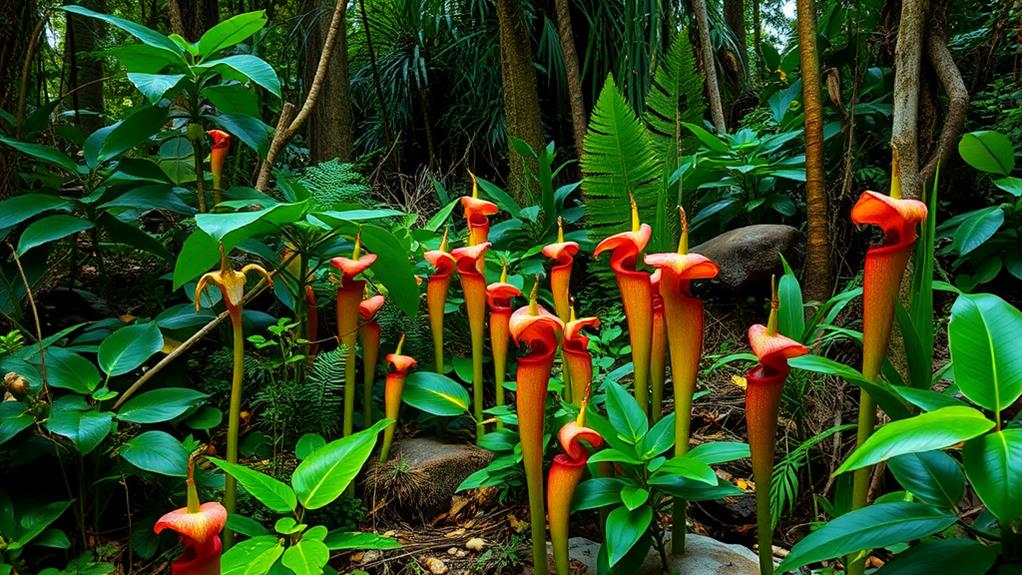
Conservation of Nepenthes species in the Philippines is crucial for preserving entire ecosystems. These carnivorous plants play a vital role in maintaining the health of their habitats through nutrient cycling.
Many Nepenthes species are threatened by habitat loss due to deforestation and agricultural expansion, making conservation efforts urgent.
For example, Nepenthes philippinensis, listed as Least Concern by the IUCN, is still vulnerable and requires habitat preservation.
Another species, Nepenthes erucoides, is significantly threatened due to its limited distribution in ultramafic habitats, which are endangered by mining activities.
Effective conservation strategies must prioritize habitat preservation to ensure these ecosystems remain intact.
Raising awareness and education about the ecological roles of Nepenthes species can promote sustainable practices among local communities and support conservation efforts.
Questions and Answers
What Are the Pitcher Plants in the Philippines?
In the Philippines, pitcher plants belong to the diverse Nepenthes genus. This genus showcases fascinating taxonomy and adaptations. For instance, there are over 150 species of Nepenthes, each with unique characteristics.
These carnivorous plants play a crucial ecological role by trapping insects. They obtain essential nutrients, such as nitrogen, phosphorus, and potassium, by digesting insects. This unique adaptation helps them thrive in nutrient-poor soils.
Many species face threats from habitat loss due to deforestation and agriculture. As a result, conservation efforts are essential to protect their habitats. For example, the Philippine government has established protected areas, such as the Mount Kitanglad Range Natural Park, to preserve the natural habitats of pitcher plants.
Understanding their ecological significance and promoting habitat protection is vital for ensuring the survival of these unique plants within their native environments. By preserving their habitats, we can safeguard the delicate balance of the ecosystem and ensure the continued existence of these remarkable plants.
Why Is the Pitcher Plant Extinct in the Philippines?
Habitat loss is the main reason why the pitcher plant is potentially extinct in the Philippines. The expansion of agriculture and tourism has led to the destruction of their natural habitats, making it difficult for these plants to survive.
This is a significant concern because pitcher plants play a crucial role in maintaining biodiversity and nutrient cycling. For instance, they provide a unique ecosystem for specific insects and microorganisms, which helps to break down organic matter and recycle nutrients.
Conservation efforts are urgently needed to protect the habitats of pitcher plants. Without targeted initiatives to preserve their natural environments, many pitcher plant species will face critical endangerment and may eventually become extinct in the Philippines and other regions.
What Is the Pitcher Plant in Palawan?
The pitcher plant in Palawan, specifically Nepenthes philippinensis, thrives in unique environments. The pitcher plant is known for its ability to survive in nutrient-poor soils and its unique pitcher-shaped leaves that trap and digest insects. This particular species, Nepenthes philippinensis, can be found in the forests of Palawan, which is home to a diverse range of endemic trees in the Philippines. These endemic trees provide the perfect habitat for the pitcher plant, as they offer shade and support for the plant to climb and reach sunlight.
It grows in montane forests with nutrient-poor, acidic soils and high humidity. This unique habitat preference allows it to play a vital ecological role by controlling insect populations.
Conservation efforts are essential because the pitcher plant faces threats from habitat loss due to deforestation and agricultural expansion.
By supporting conservation efforts, you help ensure the survival of this remarkable species and its ecological significance in the region.
What Is Unusual About the Pitcher Plant?
The pitcher plant thrives in unique habitats, such as nutrient-poor soils, where most plants struggle. This is because it has adapted to survive in environments with limited nutrients.
For example, its pitcher-shaped leaves function as traps, capturing and digesting insects to obtain essential nutrients.
The plant also attracts fascinating pollinators with vibrant colors and sweet nectar. This ensures its reproductive success by drawing in pollinators that help spread its seeds.
The combination of these features highlights the pitcher plant's survival strategy and emphasizes the intricate relationships within its ecosystem.